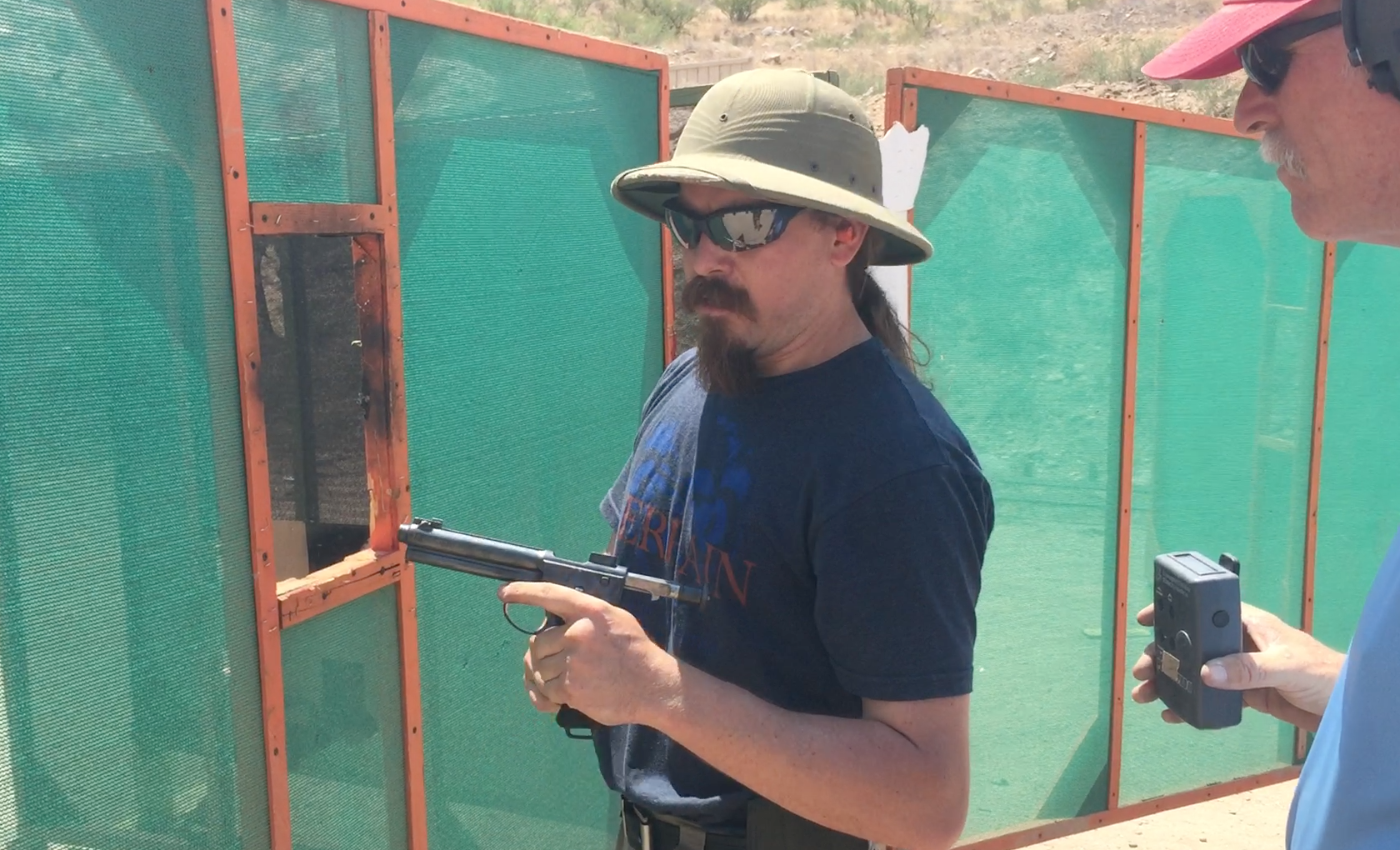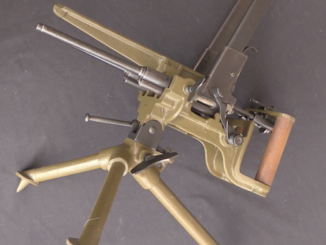Some high-speed footage of a Roth-Steyr M1907 pistol here for you – these are rotating-barrel, locked breech pistols with trigger lockwork much akin to a Glock. Namely, the action cycling puts the striker at half cock, and the first stage of the trigger press fully cocks the striker before releasing it.
Related Articles

Vintage photo
Vintage Saturday: Tactical Sweater
Volunteer member of the Albanian Legion, raised by the Austro-hungarian Army after occupying Albania in 1916. Note the Mannlicher clips of old 11mm cartridges and the C96 Mauser pistol.

Competition
Roth Steyr 1907 at a Run-n-Gun Steel Match (Video)
We have a monthly pistol competition here called Steelworkers – a bunch of stages of all steel targets. I finally accumulated enough stripper clips (3) for my 1907 Roth-Steyr to be able to compete, so […]

Prototype
Frommer Pistolen-MG Model 1917: A Crazy Villar Perosa Copy
After encountering Italian Villar Perosa machine pistols in the field, Austro-Hungarian troops requested a similar weapon. The project was given to FÉG to work on, and the result was the Pistolen-MG Model 1917: a pair […]

AWESOME Ian!!!! I own a Roth Steyr and this is a very cool look at one in action. One thing I have never been able to find are the Roth Steyr stripper clips. I know the Israelis made some once but alas they are as rare as originals and the clips are almost as pricy as the gun! One thing of note: Most 32ACP, 9mm Largo or other more common round weapons of this age usually have pitted barrels from the corrosive ammo. 8mm RS is so rare that all the Roth Steyrs I have seen have mirror-like barrels due to the lack of ammo.
I have made workable ammo from 32HR Magnum and 30 Carbine (did you know that when fire forming the 00buck shot is .320 in diameter so is perfect for use in this round in fire-forming?) I suppose one could even load 00buck as your main round but I have a Nambu mold I cast my own with. Anyway. Again your usual excellent presentation. Keep up the good work!
Awesome! Thank you.
Al
With a trigger setup like this, you don’t have to worry about accidentally shooting your own horse in the head. The only issue I have with this is the charger reloading process, not exactly convenient to do on horseback!
I think the Roth-Steyr is a most elegant handgun, possibly this is partially due to a perceived “romance” I attribute to it’s historical origins. It is an innovative design mechanically, a design which may impinge on its ergonomic functionality somewhat overall. But in conjunction with the quality of it’s construction, it certainly results in something aesthetically pleasing. A practical design, charger loading on horseback aside. I understand the tactics called for the carrying of multiple pistols in order to deliver a “salvo” as the initial engagement of a charge, before you closed with sabres so perhaps it wasn’t an issue- Fire and forget. Down a few, tally ho etc.
I have a notion for what I term a strammer “A cross between a striker and a hammer” essentially it’s a vertical striker and a horizontal one, the vertical one acts as a hammer would on a firing pin I.e. The role of the horizontal one. The idea is the trigger bar blocks the compressed vertical striker, until the trigger “attached to the bar” is pulled allowing the hammer part to pop up through a cut out in it. It impacts the striker part by way of a \ shaped suface on both pieces arranged in a manner that the striker part would move forward.
Racking the action depresses the striker under the trigger bar compressing it’s spring, via two sort of kidney shaped cams concave part facing the trigger about the size of a penny either side of it running through the hammer. That’s the drop safety I.e. The trigger bar prevents the “hammer” from rising until the trigger is pulled, as the kidney bean shaped cams rotate within the striker they impinge on a bar that runs through the hammer, horizontally compressing it against it’s spring. The trigger pull would then be equivalent to a single action break, as both components would already be cocked. The trigger could be pulled to engage the mechanism without racking the slide incase of misfires, due to the trigger bar ending in a \ shape thus depressing the hammer.
The sears etc need working out but that’s the basic idea, so in conclusion pulling the trigger after racking the slide enables the hammer to strike the cocked striker, this impact releases the striker which proceeds forward with the impetus of both springs therefore providing enough oomph to strike the primer adequately. The single action pull would perhaps be best complimented by a grip safety, of say 10lb squeeze- Easier to depress that way than via the trigger.
I think it would probably fit within the confines of a modern handgun, with bits either side of the magazine etc, a handgun specifically built to accommodate the action. Trying to fill the gap between the Glock and FN 49 type ideas. General topical interest, given the Roth-Steyrs trigger mechanism.
“kidney bean shaped cams rotate within the striker# they impinge on a bar that runs through the hammer”
Other way round I.e # = Hammer, thus hammer = Striker.
Anyway, just a thought.
“Racking the action depresses the striker# under the trigger bar compressing it’s spring” # = Hammer.
The mistakes in the text are because both parts are effectively strikers, but one acts as a hammer on a striker. Confusing, he he.
You get the idea.
I drew a picture:
http://i1142.photobucket.com/albums/n607/patrickmurphy3/st/Untitled.png
It’s an illustration of what I desribed, nothing more. I think the principle might work, in principle he he, I.e. Half cock both parts. Needs sears etc.
“impetus of both springs” well… In the sense of, the hammer I.e. The vertical striker, hits the horizontal striker- The actual striker with the force of it’s spring, and because this motion imparts a forward momentum on it due to the contact of the angled surfaces, the strikers own spring gets a boost in theory.
Said boost being required to actuate the primer, given the drop safety only applies to prevent the boost I.e. If you drop the gun, the striker- Firing pin, may well hit the primer. But with insufficient energy. Essentially half cocked. The drop safety prevents full cock I.e. Both half cocked springs acting as one full cocked one.
Quite.
Would like to see more slo-motion videos of interesting weapons. Uber cool.
I recently picked up one of these pistols because of the violent lust induced by your videos. It came with a holster and spare barrel. The previous owner explained that there were 2 different loads for the pistol, hence the second barrel. One mics at about .30 and the other .28, have you run across any mention of this being true? Both appear to be original factory barrels…
Looking for Roth-Steyr M1907 stripper-clips and holster – working condition. Came back with GI from WW2 North Africa and southern Italy tours regular Army.
Link to video needs to be fixed!